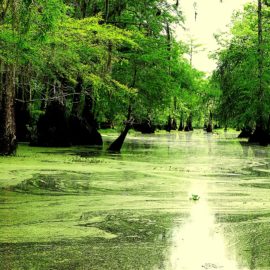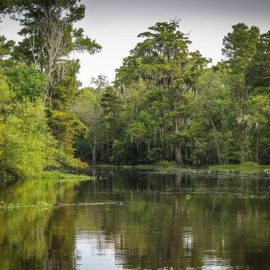
It looked good and a way to both protect the land and build more land but then the flood test.
Scientists are abandoning hope that a hardy plant from Europe can revive vast stretches of Louisiana wetlands targeted by a seemingly unstoppable plague of Asian insects. Louisiana State University biologists had been betting on bug-resistant European roseau cane as the likely replacement for local varieties of roseau, which have been in sharp decline since the tiny scale insect arrived from China a few years ago. Commonly called reeds or phragmites but known locally as roseau cane, the tall, sturdy plant is critically important for Louisiana’s fragile coast, especially the lower Mississippi River Delta, an area that is quite literally bound together by the roots of roseau. Results of a yet-to-be-published study indicate European roseau may actually be the worst option for replanting insect-ravaged areas. European roseau had the lowest survival rate of the roseau varieties and other plant species biologists cultivated at several sites where wild roseau had died out, according to research led by LSU ecologist Jim Cronin. “We definitely got some unusual results,” he said. The Delta variety, the most common type of roseau in south Louisiana, attracted far more bugs but fared better over a three-year period than its Old World counterpart. That’s likely because the varieties common to the Rhine and Danube rivers can’t survive the high-water flooding that the Delta variety thrives in. The European variety successfully shrugged off the bugs but drowned when water levels surpassed 15 inches.
nola.com
The Delta variety is a poor second choice.
It’s a hollow triumph for the Delta variety. While it fared better than European roseau, it’s still losing the bigger battle against the scale, which likely arrived in Louisiana as a cargo ship stowaway about eight years ago. The scale’s impact on roseau first triggered alarm in 2017, when fishers in south Plaquemines Parish noticed healthy stands of roseau near the Mississippi’s mouth had been reduced to shallow, open water in a matter of months. The scale sucks away roseau’s life-sustaining juices, causing the plant to wither and its thick roots to release their grip on the soil, speeding erosion. The scale has damaged hundreds of thousands of acres in Louisiana and spread to Texas, Mississippi and Alabama. Dying roseau marshes may impede river shipping, harm various near-shore fisheries, and expose hundreds of oil wells to waves and storms. “Everywhere you look, the (roseau) is getting thinner and shorter,” said LSU ecologist Andy Nyman, who helped with the study. “A lot of it is becoming open water.”

LSU AgCenter
The European variety is also invasive so not a good thing, just ask the East Coast.
Abandoning hope in European roseau may actually be a bit of a blessing. The European variety is a reviled invasive species on the East Coast and across the Great Lakes region, where it pushes out native plants, clogs waterways and requires expensive eradication efforts to keep it in check. Some Louisiana scientists thought it might be worth the hassle if it prevented large sections of the Mississippi Delta from washing away. Louisiana’s land loss crisis is especially dire in Plaquemines. Even before the scale appeared, state coastal protection officials predicted the parish could lose nearly 300 square miles, or 55% of its land area, by 2070. Scientists haven’t found the scale’s silver bullet. They can’t spray pesticides because the chemicals would harm other animals. In China, scale outbreaks are battled with fire, but burns in wet environments require large doses of toxic accelerants, and the presence of oil wells and pipelines on the coast raises safety concerns. Last year, a U.S. Department of Agriculture study suggested importing the scale’s natural adversary – an Asian parasitic wasp. But introducing another foreign species could have unforeseen consequences. The LSU study, which is awaiting peer review, also tested other wetland plants, including bulrush and cordgrass, at nine sites that had suffered roseau die-offs. By the end of the three-year study, the Delta variety covered six times as much ground as the other plants. The Delta variety’s ability to survive at the test sites may wane as the plants age and suffer more scale attacks, Cronin said. “It was only a three-year study,” he said. “It may very well be that the scale insect kills them, but in the short-term, we know that the plant that does the best is the one that’s used to living here.”

LSU
The study lead to another question.
Whether planting the Delta variety can revive stands of dying roseau is a question LSU scientists are now trying to answer. The current method of planting months-old roseau plants by hand likely isn’t a practical solution. “Right now, we’ve got to dig them up, cut the stems, grow them to a foot tall, and then carry them back out there,” Nyman said. “That’s pretty labor-intensive, and probably isn’t the way to fix this problem.”
A very pressing problem that needs a solution.


